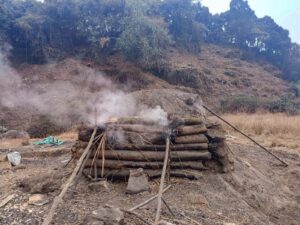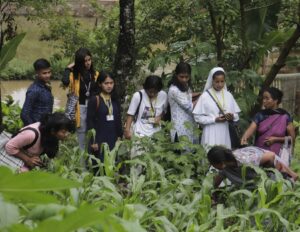Mawbri is a village located along the edge of the Sohra plateau, overlooking the Umiew River. It can be reached by taking the road to Mawkma, and after having passed the village, one must take a turn to the right and continue onto an unpaved path, which will bring them to an open spot where the village is situated. The village was founded in the 1930s. But despite approaching 100 years since its establishment, the village is still a small one—fewer than 200 people are staying in less than 30 households. Agriculture has always been the main source of livelihood for the community and the main farming systems found in the village include shifting cultivation on the steep slopes that lie along the spurs that jut out from the plateau, bun in the tableland portion, and crops grown in the homestead gardens. People also engage in fishing and hunting, which is not just a hobby but also a mode of harvesting foods from the natural landscape to supplement the foods they grow. The surrounding forest and water bodies have therefore always been important to the lives of the people.
Apart from food, various Non-Timber Forest Products (NTFPs) are also harvested from the surrounding forest, which includes the cutting of trees for charcoal production. In the past, charcoal was a very important fuel for iron smelting. This industry was quite prolific in the past, with the earliest evidence of this activity dating back more than one thousand years to a site in Raitkteng, which is in the same region. At the moment, some of the charcoal is used as fuel for household cooking, but a lot of it is sold in the market. It is a very lucrative business, and the income is higher than what can be earned from agriculture. However, the community also realizes that the indiscriminate removal of trees can have devastating consequences for the environment. For this reason, the community has divided the forest into distinct categories and has established customary rules regarding the utilization of resources from these forests.
There are three types of forest in the village:
- Law Adong
- Law Shnong
- Bri Shnong
In the first category, i.e., Law Adong, no farming or cutting of trees for charcoal production is allowed in this forest. Collection of wild vegetables, fruits, and other NTFPs, however, is permitted as long as they do not disturb the forest cover. The identification of the forest to be declared a Law Adong is based on the availability of water bodies, viz., springs and streams. This is because the function of this forest is to protect the water sources on which the village depends for drinking and cooking. Even though water is available from the common tap, people consider the water non-potable and use it only for washing and cleaning. For drinking, they will also go to the springs and ponds. Law Adong forests are thus very important for water conservation in the village. And once a portion of the forest has been declared as a Law Adong, strong rules are introduced, with the violators being made to pay heavy fines.
The second type of forest, Law Shnong, is the one in which cutting of trees for charcoal production is allowed. However, there is a system that has been put in place to manage the harvesting. Households in the community are allowed to cut trees from this forest for charcoal production for a term of only three years. This is managed through a local system known as ‘ot slip’ where numbers signifying a particular plot are written on a piece of paper, with one slip being allowed per household. The forest area allocated for harvesting is divided into equal parts based on the number of households, and the person getting a particular number (written in the slip) will be allowed to cut trees in the particular section. After the period of three years has ended, the plot goes back to the community, which keeps the land fallow for a period of 18 years to allow it to regenerate. After this period, depending on the need, the same plot can be harvested again. The fallow period is long enough for the trees to return while at the same time ensuring that households are able to earn a decent income out of it. The other use of this type of forest is also shifting cultivation, which also has a fallow period component to allow the land to recuperate. Within the same forest again, the community allocates a certain area for the people to collect firewood for household needs.
The last type, in the Bri Shnong, very similar to Law Shnong, people are allowed to practice farming and cut trees for charcoal production. The ‘ot slip’ system also applies here. The only difference is that there is no time limit prescribed for these activities. As long as the plot is being worked upon, it belongs to the household that is using it. Individuals from such households can even transfer the plots to other people, but only after informing the Durbar Shnong. However, if the household or individual holding ownership were to leave the village, the land would revert back to the community. This way, it is ensured that everyone in the village will have access to land for their sustenance and income.
The forest is very important for the people of Mawbri, and they use it not only for conserving the water resources in the community but also for growing food and cutting trees to earn valuable income through the sale of charcoal. This is achieved by dividing the forest into three different types with specific rules for each category of forest. Rules such as the ‘ot slip’ system regulates access and cutting of trees at specific sites. It is because of this form of natural resource management that the community has been able to not just protect the forests that are found in the areas under its jurisdiction but also improve the lives of the community through a sustainable harvesting model while maintaining community control over land so that everyone in the community can have access to land for their needs.
This story has been documented as part of the TNC-supported NESFAS’ project “Protection of forests in Meghalaya by adopting participatory, gender-centric, and equitable approaches.”




